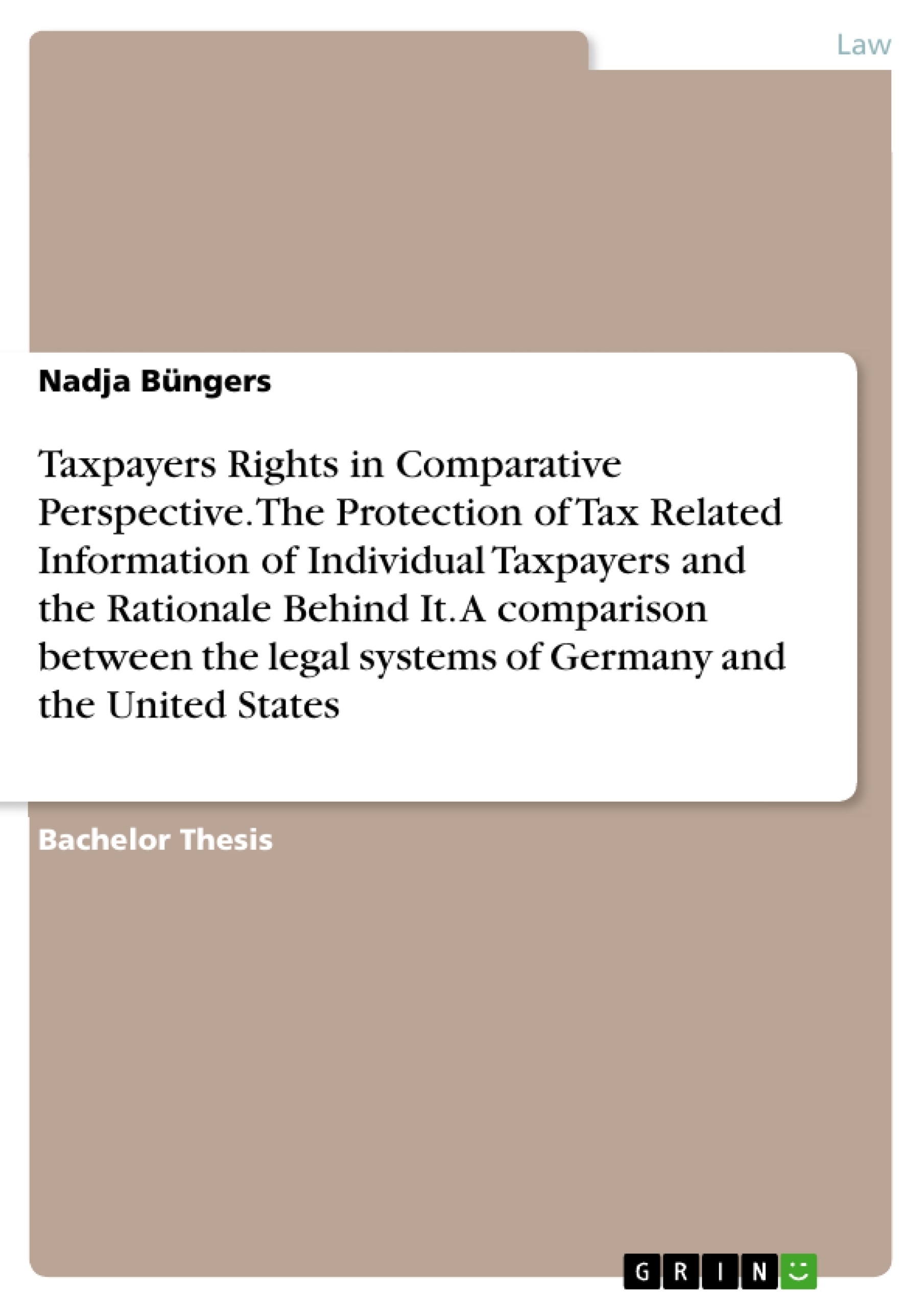Taxpayers are obliged to file their annual returns which the state needs to fund its expenses for society. By doing so, sensitive and personal information are disclosed to the respective tax administration. Inevitably, the issue of disclosing relevant information arises as well as the question of how to treat the information without harming the basic rights of an individual taxpayer. This thesis contributes to the issue of disclosing tax related information by focusing on tax confidentiality, its development and status, the current legal framework, and the rationale behind the approaches of tax confidentiality, undertaken by different legal systems. More specific, this thesis incorporates a comparison between the jurisdictions of Germany and the United States, examining their national legislative rules on tax confidentiality. By elaborating upon the similarities, differences, and the rationale of tax confidentiality in both systems, the thesis will uncover the fact, that both, Germany and the U.S. have a high level of confidentiality. There exist, however, interesting differences related to the level of confidentiality, and this thesis will conclude that the German system has a higher level of confidentiality, for instance in relation to the exceptions to tax confidentiality.
Inhaltsverzeichnis (Table of Contents)
- Introduction
- I Germany
- Historical Development of Tax Confidentiality
- Legal Framework of Tax Confidentiality
- § 30 (1) and § 30 (3) AO – The Scope of Tax Confidentiality
- § 30 (2) AO - Breach of Duty
- § 30 (4) AO – Exceptions to Tax Confidentiality
- § 30 (5) AO – Disclosure in case of Intentional False Statements
- § 40 AO-Actions contrary to the Law
- Consequences of a Violation of § 30
- II United States of America
- Historical development of Tax confidentiality
- Legal Framework of Tax Confidentiality
- Freedom of Information Act and Internal Revenue Code
- § 6103 (a) and § 6103 (b) IRC - Definitions
- § 6103 (c) IRC – Disclosure of Returns and Return information to designee of Taxpayer
- § 6103 (h) (4) IRC - Disclosure in juridical and administrative proceedings
- § 6103 (m) - Disclosure of Taxpayer Identity Information
- § 6110 IRS – Public Inspection of Written Documents
- III Comparison
- Historical Development of Tax Confidentiality
- Confidentiality as a right - Status in Constitution
- Legal Framework of Tax Confidentiality
- Possible Exceptions to Tax Confidentiality
- Violation of Tax Confidentiality
- IV Rationale
Zielsetzung und Themenschwerpunkte (Objectives and Key Themes)
This thesis examines the protection of tax-related information of individual taxpayers, focusing on the concept of tax confidentiality. The work compares the legal systems of Germany and the United States, investigating their respective frameworks for protecting this sensitive information and the rationale behind these approaches.
- Tax confidentiality and its development across different legal systems
- The current legal frameworks for tax confidentiality in Germany and the United States
- The rationale behind the approaches to tax confidentiality in both jurisdictions
- A comparative analysis of the similarities and differences in the level of tax confidentiality between Germany and the United States
- The potential impact of exceptions to tax confidentiality on taxpayer rights
Zusammenfassung der Kapitel (Chapter Summaries)
- Introduction: This chapter introduces the fundamental concept of tax confidentiality and its significance in protecting taxpayers' rights. It establishes the importance of safeguarding sensitive financial information while ensuring efficient tax administration.
- I Germany: This section delves into the historical development of tax confidentiality in Germany, outlining the legal framework that currently governs this area. It examines specific provisions of the German Fiscal Code (Abgabenordnung, AO) related to the scope of tax confidentiality, exceptions, breaches of duty, and consequences of violating these provisions.
- II United States of America: This chapter focuses on the historical evolution and current legal framework of tax confidentiality in the United States. It explores the Freedom of Information Act (FOIA), the Internal Revenue Code (IRC), and key provisions related to disclosure of tax information, taxpayer identity, and public inspection of documents.
- III Comparison: This chapter compares the historical development, constitutional status, legal framework, and exceptions to tax confidentiality in Germany and the United States. It highlights both similarities and differences in the level of protection afforded to taxpayers in each jurisdiction.
- IV Rationale: This section explores the underlying rationale behind the different approaches to tax confidentiality adopted by Germany and the United States. It analyzes the policy arguments and justifications underpinning the legal frameworks in each country.
Schlüsselwörter (Keywords)
This thesis focuses on the central theme of **tax confidentiality**, examining its historical development, legal frameworks, and rationale in Germany and the United States. Key concepts include **tax compliance, tax transparency, taxpayer privacy, and the balance between safeguarding sensitive information and ensuring effective tax administration.**
- Quote paper
- Nadja Büngers (Author), 2017, Taxpayers Rights in Comparative Perspective. The Protection of Tax Related Information of Individual Taxpayers and the Rationale Behind It. A comparison between the legal systems of Germany and the United States, Munich, GRIN Verlag, https://www.grin.com/document/379630



